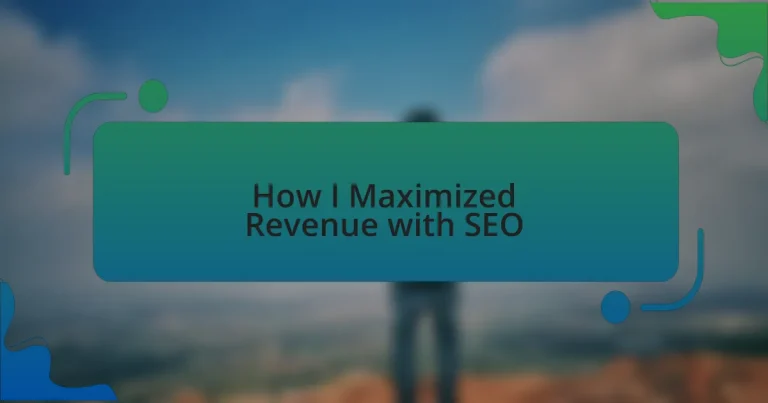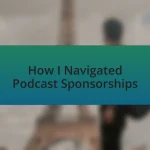Key takeaways:
- Understanding and effectively using SEO strategies, such as keyword optimization, significantly enhances travel blog visibility and audience reach.
- Engaging content, including personal anecdotes and high-quality visuals, fosters deeper connections with readers and promotes interaction.
- Optimizing images with descriptive alt text and appropriate file sizes improves site performance and accessibility while aiding in SEO efforts.
- Analyzing traffic metrics reveals insights about audience preferences, allowing bloggers to tailor content to boost engagement and revenue.
Author: Evelyn Hartley
Bio: Evelyn Hartley is a bestselling author known for her compelling historical novels that delve into the complexities of human relationships. With a background in literature and a passion for storytelling, she crafts richly detailed narratives that transport readers to different eras. Her award-winning debut novel, “Whispers of the Past,” was praised for its vivid characters and intricate plots. When she’s not writing, Evelyn enjoys exploring antique shops and researching the fascinating stories behind forgotten artifacts. She resides in a charming cottage in Vermont, where she draws inspiration from the beauty of nature and the stories it holds.
Understanding SEO for Travel Blogs
When I first dove into travel blogging, I quickly realized that understanding SEO was like opening a treasure chest. Search engine optimization helps your content reach a wider audience by improving your visibility on search engines. Have you ever wondered why some travel blogs pop up on the first page while others are buried? The difference often lies in their SEO strategies.
I remember feeling overwhelmed by all the technical jargon, but breaking it down made a world of difference. Keywords, for example, are the phrases potential readers type into search engines. I had to learn to identify and use specific keywords related to my travel experiences—like “eco-friendly travel tips” or “hidden gems in Spain”—to attract those searching for exactly what I offered.
Furthermore, it’s crucial to think about user experience—does your blog load quickly? Is it mobile-friendly? I’ve come to appreciate that SEO isn’t just about rankings; it’s about creating an enjoyable journey for my readers. Engaging content, paired with a solid SEO foundation, ensures that my travel stories resonate and reach those adventurers eager for inspiration.
Content Creation for Travel Engagement
Content creation in travel blogging goes beyond mere storytelling; it’s about crafting experiences that captivate and engage readers. I once wrote a piece about my trip to the Amalfi Coast, focusing not just on the sights, but the emotions I felt while wandering those vibrant streets. I’ve found that sharing personal anecdotes like my spontaneous gelato stop created a deeper connection with my audience. Have you ever shared a moment that made a place unforgettable? Those are the words that stick with readers, inviting them into your world.
Visual content is another cornerstone of engagement. High-quality images do wonders to complement your narratives; they can transport a reader before they’ve even finished the first paragraph. I remember investing time into capturing the sunset over Santorini. When I shared that stunning photo alongside my tale of exploring the island, it sparked conversations with my followers. It’s fascinating how a single picture can ignite wanderlust and lead to meaningful interactions in the comments.
Finally, I discovered that asking questions within my content invites readers to reflect and engage. Simple prompts like “What’s your favorite travel memory?” turn passive readers into active participants. When I pose such questions, I often receive heartfelt responses that enhance the community feel of my blog. It’s amazing how a little bit of dialogue can foster a sense of belonging among fellow travel enthusiasts. That’s the beauty of content creation—it’s a two-way street where stories unfold and connections blossom.
Optimizing Images for Travel Blogs
Optimizing images for travel blogs involves more than just uploading photos; it’s about ensuring that each image enhances both the aesthetic appeal and performance of your site. When I first started, I overlooked the importance of including descriptive alt text for my images. However, I soon realized that this not only helps with SEO but also improves accessibility for visually impaired readers. Have you ever thought about how a well-documented image can reach an audience beyond just the visual experience?
Image file size is another crucial element. I remember the frustration of my blog loading slowly because I had large files that weren’t compressed. After optimizing those images, my site speed improved significantly, leading to better user experience and increased visitor retention. How often do we abandon a page if it takes too long to load? By optimizing your images, you can keep your readers engaged rather than waiting impatiently.
Additionally, incorporating keywords into your image titles can drive traffic from search engines. I learned this when I titled an image of a bustling Tokyo market with relevant keywords rather than a generic name. This not only helped potential readers find my content but also resonated with their search intent. Think about it: what keywords do you think best describe the experiences captured in your travel photos?
Analyzing Traffic and Revenue Growth
Analyzing traffic and revenue growth is like tuning into the heartbeat of your travel blog. I recall the moment I connected my Google Analytics account and saw my visitor numbers spike after implementing SEO strategies. The thrill of watching those numbers rise, and understanding what content resonated with my audience, was incredible. Have you ever felt that rush when you realize your efforts are paying off?
It’s essential to dig deeper than surface-level statistics. When I examined which posts brought in not just views but actual bookings or affiliate sales, I discovered my audience craved specific travel itineraries rather than general tips. This insight allowed me to tailor my content further, centering around those lucrative topics. What would happen if you focused on what your readers really want?
Moreover, monitoring my bounce rate proved invaluable in refining my approach. I recognized that certain pages weren’t keeping visitors engaged, prompting me to enhance their content or layout. By consistently analyzing these metrics, I began to create a cycle of improvement, driving both traffic and revenue growth in a way I hadn’t anticipated. How often do you check in on what keeps your visitors from clicking away?
Personal Insights on SEO Success
Recognizing the importance of keyword research transformed my approach to SEO. There was a point when I stumbled upon a niche keyword related to eco-friendly travel that seemed to have low competition. My initial post on that topic not only attracted traffic but also generated a surprising number of inquiries from readers wanting more information. Have you ever hit the sweet spot with a topic that just clicks with your audience?
Another eye-opening moment was when I realized the impact of optimizing images on my blog. After I took the time to add descriptive alt tags to my travel photos, I noticed a nice uptick in organic search traffic. It made me reflect: how often do we overlook the simplest elements that could enhance our content’s discoverability?
Community engagement through social media also played a key role in my SEO success. When I began sharing snippets of my posts and engaging with followers, it created a ripple effect. Friends and followers began sharing my content, expanding my reach significantly. Isn’t it fascinating how building relationships can lead to greater visibility in a crowded online space?




